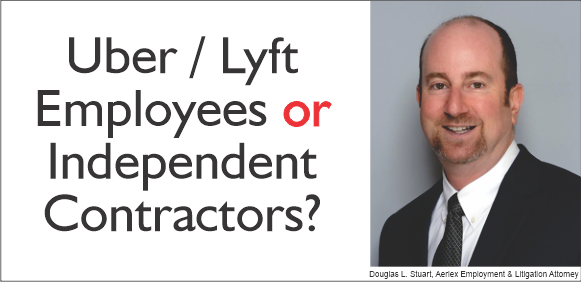Uber & Lyft: Employees or Independent Contractors?
CALIFORNIA COURT UPHOLDS STATE STATUTE THAT FURTHER LIMITS INDEPENDENT CONTRACTOR CLASSIFICATION
Aerlex has kept our clients up to date on California’s ongoing legal scrum over the proper classification of workers between employee and independent contractor. As we have been writing, the opportunities to classify workers as independent contractors continues to narrow. This past week, a California trial judge in San Francisco continued this trend in ruling that Uber and Lyft must treat their drivers as employees under California law in today’s “gig” economy. Gig workers traditionally have been independent contractors, online platform workers, contract firm workers, on-call workers and temporary workers.
In 2019, California passed Assembly Bill 5, a state statute that expands a landmark Supreme Court of California case, Dynamex Operations West, Inc. v. Superior Court. In that case, the court held that most workers are employees and the burden of proof for classifying individuals as independent contractors belongs to the hiring entity. AB 5 entitles workers classified as employees to greater labor protections, such as minimum wage laws, sick leave, and unemployment and workers’ compensation benefits, which do not apply to independent contractors.
AB 5, now California Labor Code Section 2750.3 and effective January 1, 2020, places the burden of proof on employers to show that a worker is properly classified as an independent contractor only where all three of the following conditions are met:
-
the worker is free from the control and direction of the hirer in connection with the performance of the work, both under the contract for the performance of such work and in fact;
-
the worker performs work that is outside the usual course of the hiring entity’s business; and
-
the worker is customarily engaged in an independently established trade, occupation, or business of the same nature as the work performed for the hiring entity.
In response to the passage of AB 5, several industries lobbied the legislature for exemptions, in particular, Uber and Lyft, neither of which was granted an exemption. Because both continued to treat their drivers as independent contractors, in May 2020, California Attorney General Xavier Becerra sued Uber and Lyft, alleging the ride-hailing companies have misclassified their drivers as contractors in violation of a new state law. On August 10, 2020, California Superior Court Judge Ethan Schulman issued his ruling, stating that Uber and Lyft must treat their drivers as employees under AB 5, as their work was not outside the usual course of their business but simply transportation companies that fell within AB 5’s provisions. We anticipate the filing of an appeal to Judge Schulman’s decision is imminent.
On the 2020 ballot is an initiative to reverse AB 5 as Proposition 22, and if it passes, then app-based transportation rideshare and delivery drivers will be classified as independent contractors, superseding the recent court cases.
Although this August 10, 2020 ruling from Judge Schulman in San Francisco was limited to Uber and Lyft, it continues the trend toward classifying more workers as employees and increases the potential risk to employers who may misclassify workers as independent contractors. With this in mind, it is important to undertake a proper analysis of all workers to determine if each is categorized correctly.
If you need any assistance in making this determination, we encourage you to contact Doug Stuart, Aerlex’s litigation and employment counsel, at Dstuart@Aerlex.com.

